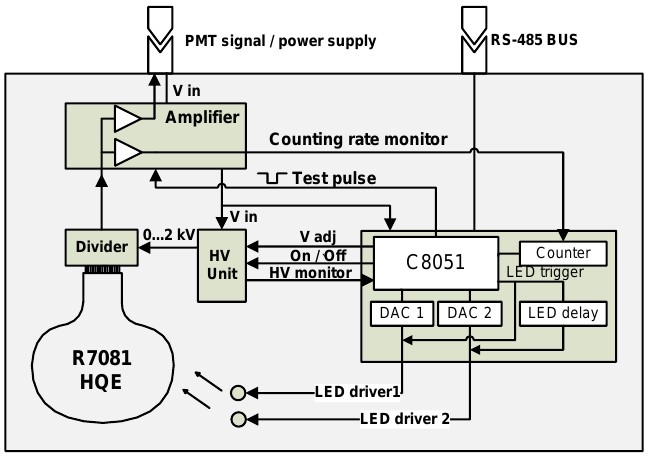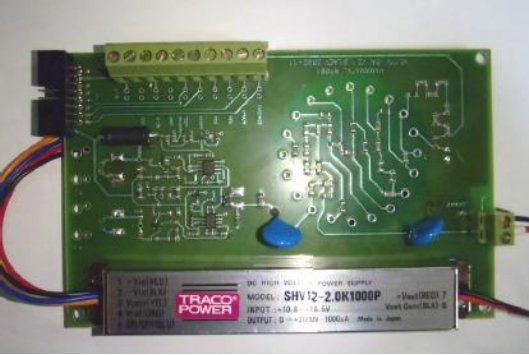

Photomultiplier tube
The choice of the optimal type of photomultiplier tube for the BAIKAL-GVD is a top priority task. The main requirements to PMT are high time resolution (at a level of several nanoseconds), large photocathode area, and high quantum efficiency. Currently, only Hamamatsu-R8055 and Hamamatsu-R7081HQE PMTs with hemispherical photocathodes satisfy the requirements of the BAIKAL-GVD experiment. PMTs R8055 and R7081HQE have, respectively, the following characteristics: the photocathode area ~1000 cm2 and ~500 cm 2 and the quantum efficiency ~0.2 and more than 0.3. PMTs of both types were tested as components of engineering arrays in Lake Baikal. At present R7081HQE is chosen as a light sensor of the BAIKAL-GVD (see Fig 1). The photomultiplier is fed by a high-voltage TRACO POWER SHV12-2.0K1000P DC/DC converter through a voltage divider with a resistance of 18 MΩ. Working voltage from the range 1300 – 1800 V is selected to provide a gain of the dynode PMT system of ~10^7. To provide reliable operation of the spectrometric channels of the telescope, the PMT signal is additionally amplified by a factor of 12 (the first amplifier channel). This amplification level provides both a sufficiently high average single-electron PMT signal (30-40 mV) with respect to the noise pulse amplitude in the spectrometric channel and the necessary range of linearity up to 100 photoelectrons (p.e.). Two-channel amplifier unit and PMT voltage divider are placed on the same board. The first amplifier channel is used for spectrometric measurements and the second channel (amplification factor 25) serves to amplify signals arriving at the noise pulse counter of the photomultiplier. The amplifier/divider board is shown in Fig. 2.
Controller


Design of optical module
Angular sensitivity of OM
The information about the angular dependence of the optical module response to
Cherenkov radiation is of primary importance for simulating the processes of muon
and shower detection in the BAIKAL-GVD. The angular sensitivities were measured
for selected OM samples using a diffuse light source with a wavelength of 445 nm,
mounted at a distance of 2.5 m from the optical module. The optical module under
study was placed in a water-filled tank. Figure 5 presents the results of measuring
the angular sensitivities of OMs based on PMT R8055, ХР1807 (Photonis), and
R7081HQE.


- Home
- Hardware
- Software & Data
- Collaboration
- Publications
- News & Media
- Photos & Video
- Contacts

